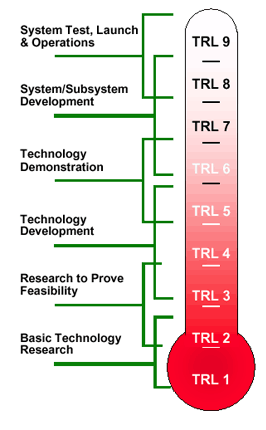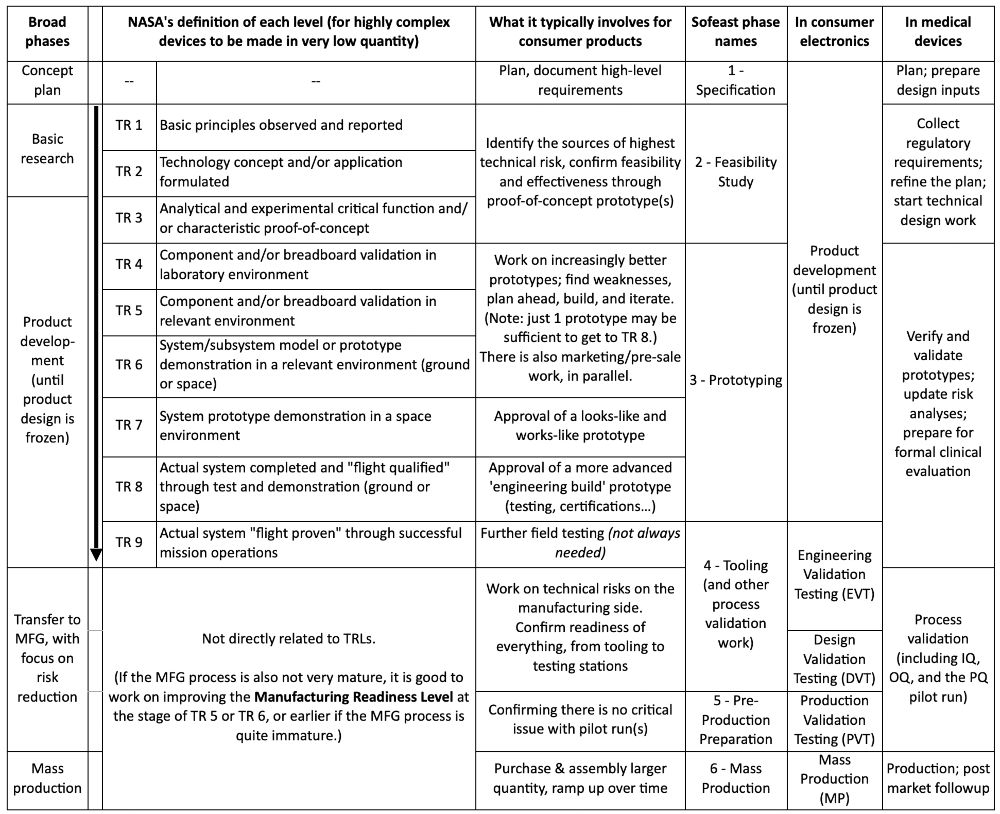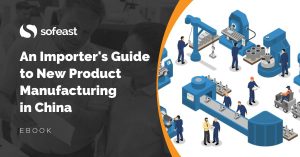Does the Technology Readiness Levels framework (TRL) developed by NASA make sense for your product development situation?
Let’s compare it to other development frameworks, including medical devices and consumer electronics, to see how the TRLs are related and helpful as milestones to focus on during the development process.
What are the TRLs?
The technology readiness levels framework was developed by NASA in the 70s because developing a new space vehicle system required an enormous amount of work and a very structured approach to prototyping and validations. Although widely used in the space exploration industry to the point where it is included in ISO 16290:2013 Space systems — Definition of the Technology Readiness Levels (TRLs) and their criteria of assessment, it can be used in most industries and we have found it to be most widely adopted by our European clients.
Primarily an R&D tool, the TRL is a product development framework split into 9 distinct levels that helps manage the research & development choices a company needs to make. After you have defined what you want to build in a concept plan, the TRL framework can be implemented. It starts off at level 1 if the technology is at an early stage and still quite immature, and ends with mature technology where R&D is all but complete and the product design is fully validated at level 9. (However, it does NOT mean it is ready for mass production, as we will discuss).
According to NASA, the TRLs can be broken down into 5 categories:
- Basic research in new technologies and concepts.
- Focused technology development addressing specific technologies for one or more potential identified applications.
- Technology development and demonstration for each specific application before the beginning of full system deployment.
- System development (through first unit fabrication).
- System ‘launch’ and operations.
To give you an idea of how the different technology readiness levels fit together, let’s look at NASA’s own graphic:

Source: NASA
Interestingly, the TRL can be described as ‘technology milestones,’ so you can understand why it is used as a framework to manage the product development process (reliability testing alone can be very complex, for instance, so solid project management is a really important discipline for manufacturers who’re developing and manufacturing a new product).
How to use technology readiness levels when developing your general consumer product?
Based on NASA’s original framework, a more general-purpose TRL framework we use at Sofeast includes the 6 phases and incorporates the TRLs:
- Specification
- Feasibility study
- Prototyping
- Tooling (and other process validation work)
- Pre-production preparation
- Mass production
NASA’s framework doesn’t really consider the last two phases as they produce units that tend to be hand-made in tiny quantities, therefore transferring to manufacturing and mass production were not such an issue for them as they are for today’s manufacturers of products made in thousands (or the millions), hence we include these sections.
I talk you through the framework in this video:
You can see the framework we use at Sofeast below (the Sofeast phase names column) and how it corresponds with NASA’s Technology Readiness Levels:

Let’s go through each phase and how the TRLs relate to them:
Specification
This is where you define what you expect from the product. Translate the users’ needs and the regulatory and other requirements into a series of specifications, as detailed as possible. Performing market research here to determine user needs and demands is really important.
Feasibility study
This includes TR1 (Basic principles observed and reported) and TR2 (Technology concept and/or application formulated). This is where you begin to identify the sources of the highest technical risk and confirm feasibility and effectiveness through proof-of-concept prototype(s). Some companies won’t need to do this and can skip straight to the next phase, starting with TR3.
Prototyping
In the product development stage, a lot of work gets done. We produce increasingly better prototypes; find weaknesses, plan ahead, build, and iterate them.
(Note: just 1 prototype may be sufficient to get to TR 8.)
There is also marketing/pre-sale work, in parallel.
Start with a proof of concept focusing on the few critical functions and seeing if it can be made to work. In TR3 and 4 we validate some of the components. Test and validate that the product works in a replicated typical use environment. TR 5-7 are done in parallel a lot of the time.
By TR 7 and 8 you need to have considered DFM and DFQ, otherwise, it’s risky to approve your prototype as it may not actually be manufacturable to your required level of quality. Reliability, durability, and compliance testing typically occurs during TR 7 to 9.
Tooling (and other process validation work)
TR 9 may or may not be required, it depends on the product. If the product is built for use in a very specific environment, such as extreme polar conditions, for example, further testing in those conditions may be prudent in order to confirm that the design and prototypes are ready to be ‘locked.’ When time pressure is intense, it may be OK to start making tooling (if needed).
In parallel, depending on the type of manufacturing & testing processes are involved, there may be a lot of work to validate those processes. It is better to start early and work on it in parallel with R&D work.
Pre-production preparation
There is still a lot of engineering work to do in order to assure that we’re ready to start mass production.
Pre-production pilot runs are always a must for new products – this is a final opportunity to check that the product design is manufacturable, that the manufacturing process, operators, and materials/components are all working as expected and that the product can be manufactured in volume.
Mass production
Now design and production processes have been validated, we’re ready to start mass production. The final thing to do is purchase and assemble larger quantities of the products, ramping up over time.
How are TRLs related to the consumer electronics development process?
In consumer electronics, the typical “NPI” (New Product Development) framework includes the TRLs as well as the phases needed until mass production.
- Product Development (PD) equivalent of the concept plan and TR 1 to 8.
- Engineering Validation Testing (EVT) is the start of transfer to manufacturing. TR 9 may take place in parallel, and even in some cases TR 8.
- Design Validation Testing (DVT) is a part of the transfer to manufacturing phase.
- Production Validation Testing (PVT) is a part of the transfer to manufacturing phase.
- Mass production (MP) – everything has been validated and the electronics can be mass produced; there is still work to improve the first-pass yield etc. until it is considered mature.
How are TRLs related to the medical device development process?
Medical devices, too, can implement the technology readiness levels during product development.
- There’s the initial planning stage where we prepare the design inputs and guide the engineers on what they’ll have to work with.
- Collecting regulatory requirements is critical for medical devices. Then we refine the plan and start technical design work. Initial risk analysis is also performed here, so this part of the process is very document-heavy. TR 1 to 3 might be done in parallel.
- Development work proceeds, and the resulting prototypes are verified and validated (with user testing and maybe an early clinical trial); updating risk analyses; and preparing for formal clinical evaluation (which may take place after the design is frozen and a small pilot production run has been completed). TR 4 to 9 are all covered in this phase.
- Process validation (including IQ, OQ, and the PQ pilot run) is very important. This includes on- and off-site installation qualification of new production equipment (if any), operational qualification, and production qualification that usually involves a pilot run and is relatively similar to PVT and pre-production preparation.
- Then you go into production. As with all medical devices, gathering feedback from users and patients is an important activity, as this post-market follow-up can help you to further improve the efficacy and safety of the device in future.
Conclusion
The original technology readiness levels framework from NASA isn’t for everyone, but TRLs can be useful as milestones you need to reach during the product development process regardless of whether you’re following the original framework, Sofeast’s more general framework, or those specific to consumer electronics and medical devices. A big difference between NASA’s original TRL framework and the others is that NASA didn’t focus on pre-production preparation and mass production in theirs as their devices were only produced in small batches mostly by hand, so when using a development and manufacturing framework for mass-produced goods these elements are critical.
Are you designing, or developing a new product that will be manufactured in China?
Sofeast has created An Importer’s Guide to New Product Manufacturing in China for entrepreneurs, hardware startups, and SMEs which gives you advance warning about the 3 most common pitfalls that can catch you out, and the best practices that the ‘large companies’ follow that YOU can adopt for a successful project.
It includes:
- The 3 deadly mistakes that will hurt your ability to manufacture a new product in China effectively
- Assessing if you’re China-ready
- How to define an informed strategy and a realistic plan
- How to structure your supply chain on a solid foundation
- How to set the right expectations from the start
- How to get the design and engineering right
Just hit the button below to get your copy (please note, this will direct you to my company Sofeast.com):


